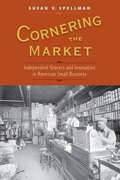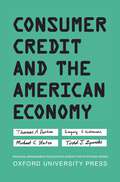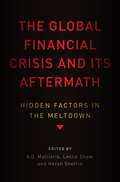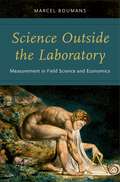- Table View
- List View
Can Microfinance Work?: How to Improve Its Ethical Balance and Effectiveness
by Lesley SherrattMicrofinance began with the noble aim of alleviating poverty through the extension of small loans to poor borrowers, and has grown to now serve approximately 200,000,000 people-the majority of whom are female. Yet despite claims to the contrary, the practice has not been proven to have succeeded in either enriching or empowering its borrowers. In a thorough-going ethical assessment of the industry, Can Microfinance Work? examines the central microfinance model and whether or not it is effective, the extent to which the practice creates the conditions for exploitation and coercion to occur, and whether the distribution of the benefits and burdens of microfinance is likely to be an ethical one. Author Lesley Sherratt argues for the establishment of a duty of care in microfinance in recognition of the vulnerability of the client base. She also examines the ethical dilemmas inherent in working in the informal sector, as well as microcredit's macro impact on economies. From there, Sherratt draws some wider lessons microfinance can offer anti-poverty developments in general. Challengingly, the book considers how microfinance might be reformed to ensure it is practiced both more ethically and effectively, and in doing so, argues that only a part of the industry may survive in its current form. The bulk could instead bifurcate in to one of two camps, either scaling down to become predominantly savings rather than credit vehicles, probably subsidized; or scaling up to provide credit to small and medium enterprise lending operations. For the rest, it is argued that establishing a non-exploitative interest rate, ending the practice of group liability, and fully specifying a duty of care -- with, if necessary, regulation developed to enforce these -- are microfinance's urgent ethical priorities.
The Oxford Handbook of the Economics of the Pacific Rim (Oxford Handbooks)
by Inderjit KaurThe Pacific Rim is a dynamic and diverse economic region, containing the world's three largest economies (US, China, and Japan), as well as many of the world's fastest growing and emerging market economies. Trans-Pacific economic exchange, including trade and capital movements, has been an important driver of the world economy, simultaneosly contributing to growth and global imbalances. Within the Asia-Pacific region there has been an increase in trade and investment, as well as the development of value chain linkages through outsourcing and foreign direct investment. The new debate in this region centers around managing this economic integration and the vagaries of globalization while supporting continued high growth. The Oxford Handbook of the Economics of the Pacific Rim provides institutional and historical perspectives on the Pacific Rim's unique economic situation, considers various dimensions of economic policies, and examines the growth process and specific challenges to growth. It discusses the key theme of regional economic integration in its many dimensions, including trade, investment, monetary coordination, crisis management, and value networks.
Cornering the Market: Independent Grocers and Innovation in American Small Business
by Susan V. SpellmanIn popular stereotypes, local grocers were avuncular men who spent their days in pickle-barrel conversations and checkers games; they were backward small-town merchants resistant to modernizing impulses. Cornering the Market challenges these conventions to demonstrate that nineteenth- and early-twentieth-century grocers were important but unsung innovators of business models and retail technologies that fostered the rise of contemporary retailing. Small grocery owners revolutionized business practices from the bottom by becoming the first retailers to own and operate cash registers, develop new distribution paths, and engage in transforming the grocery trade from local enterprises to a nationwide industry. Drawing on storekeepers' diaries, business ledgers and documents, and the letters of merchants, wholesalers, traveling men, and consumers, Susan V. Spellman details the remarkable achievements of American small businessmen, and their major contributions to the making of "modern" enterprise in the United States. The development of mass production, distribution, and marketing, the growth of regional and national markets, and the introduction of new organizational and business methods fundamentally changed the structures of American capitalism. Within the walls of their stores, proprietors confronted these changes by crafting solutions centered on notions of efficiency, scale, and price control. Without abandoning local ties, they turned social concepts of community into commercial profitability. It was a powerful combination that businesses from chain stores to Walmart continue to exploit today.
Cornering the Market: Independent Grocers and Innovation in American Small Business
by Susan V. SpellmanIn popular stereotypes, local grocers were avuncular men who spent their days in pickle-barrel conversations and checkers games; they were backward small-town merchants resistant to modernizing impulses. Cornering the Market challenges these conventions to demonstrate that nineteenth- and early-twentieth-century grocers were important but unsung innovators of business models and retail technologies that fostered the rise of contemporary retailing. Small grocery owners revolutionized business practices from the bottom by becoming the first retailers to own and operate cash registers, develop new distribution paths, and engage in transforming the grocery trade from local enterprises to a nationwide industry. Drawing on storekeepers' diaries, business ledgers and documents, and the letters of merchants, wholesalers, traveling men, and consumers, Susan V. Spellman details the remarkable achievements of American small businessmen, and their major contributions to the making of "modern" enterprise in the United States. The development of mass production, distribution, and marketing, the growth of regional and national markets, and the introduction of new organizational and business methods fundamentally changed the structures of American capitalism. Within the walls of their stores, proprietors confronted these changes by crafting solutions centered on notions of efficiency, scale, and price control. Without abandoning local ties, they turned social concepts of community into commercial profitability. It was a powerful combination that businesses from chain stores to Walmart continue to exploit today.
Consumer Credit and the American Economy (Financial Management Association Survey and Synthesis)
by Thomas A. Durkin Gregory Elliehausen Michael E. Staten Todd J. ZywickiConsumer Credit and the American Economy examines the economics, behavioral science, sociology, history, institutions, law, and regulation of consumer credit in the United States. After discussing the origins and various kinds of consumer credit available in today's marketplace, this book reviews at some length the long run growth of consumer credit to explore the widely held belief that somehow consumer credit has risen "too fast for too long." It then turns to demand and supply with chapters discussing neoclassical theories of demand, new behavioral economics, and evidence on production costs and why consumer credit might seem expensive compared to some other kinds of credit like government finance. This discussion includes review of the economics of risk management and funding sources, as well discussion of the economic theory of why some people might be limited in their credit search, the phenomenon of credit rationing. This examination includes review of issues of risk management through mathematical methods of borrower screening known as credit scoring and financial market sources of funding for offerings of consumer credit. The book then discusses technological change in credit granting. It examines how modern automated information systems called credit reporting agencies, or more popularly "credit bureaus," reduce the costs of information acquisition and permit greater credit availability at less cost. This discussion is followed by examination of the logical offspring of technology, the ubiquitous credit card that permits consumers access to both payments and credit services worldwide virtually instantly. After a chapter on institutions that have arisen to supply credit to individuals for whom mainstream credit is often unavailable, including "payday loans" and other small dollar sources of loans, discussion turns to legal structure and the regulation of consumer credit. There are separate chapters on the theories behind the two main thrusts of federal regulation to this point, fairness for all and financial disclosure. Following these chapters, there is another on state regulation that has long focused on marketplace access and pricing. Before a final concluding chapter, another chapter focuses on two noncredit marketplace products that are closely related to credit. The first of them, debt protection including credit insurance and other forms of credit protection, is economically a complement. The second product, consumer leasing, is a substitute for credit use in many situations, especially involving acquisition of automobiles. This chapter is followed by a full review of consumer bankruptcy, what happens in the worst of cases when consumers find themselves unable to repay their loans. Because of the importance of consumer credit in consumers' financial affairs, the intended audience includes anyone interested in these issues, not only specialists who spend much of their time focused on them. For this reason, the authors have carefully avoided academic jargon and the mathematics that is the modern language of economics. It also examines the psychological, sociological, historical, and especially legal traditions that go into fully understanding what has led to the demand for consumer credit and to what the markets and institutions that provide these products have become today.
Consumer Credit and the American Economy (Financial Management Association Survey and Synthesis)
by Todd J. Zywicki Michael E. Staten Thomas A. Durkin Gregory ElliehausenConsumer Credit and the American Economy examines the economics, behavioral science, sociology, history, institutions, law, and regulation of consumer credit in the United States. After discussing the origins and various kinds of consumer credit available in today's marketplace, this book reviews at some length the long run growth of consumer credit to explore the widely held belief that somehow consumer credit has risen "too fast for too long." It then turns to demand and supply with chapters discussing neoclassical theories of demand, new behavioral economics, and evidence on production costs and why consumer credit might seem expensive compared to some other kinds of credit like government finance. This discussion includes review of the economics of risk management and funding sources, as well discussion of the economic theory of why some people might be limited in their credit search, the phenomenon of credit rationing. This examination includes review of issues of risk management through mathematical methods of borrower screening known as credit scoring and financial market sources of funding for offerings of consumer credit. The book then discusses technological change in credit granting. It examines how modern automated information systems called credit reporting agencies, or more popularly "credit bureaus," reduce the costs of information acquisition and permit greater credit availability at less cost. This discussion is followed by examination of the logical offspring of technology, the ubiquitous credit card that permits consumers access to both payments and credit services worldwide virtually instantly. After a chapter on institutions that have arisen to supply credit to individuals for whom mainstream credit is often unavailable, including "payday loans" and other small dollar sources of loans, discussion turns to legal structure and the regulation of consumer credit. There are separate chapters on the theories behind the two main thrusts of federal regulation to this point, fairness for all and financial disclosure. Following these chapters, there is another on state regulation that has long focused on marketplace access and pricing. Before a final concluding chapter, another chapter focuses on two noncredit marketplace products that are closely related to credit. The first of them, debt protection including credit insurance and other forms of credit protection, is economically a complement. The second product, consumer leasing, is a substitute for credit use in many situations, especially involving acquisition of automobiles. This chapter is followed by a full review of consumer bankruptcy, what happens in the worst of cases when consumers find themselves unable to repay their loans. Because of the importance of consumer credit in consumers' financial affairs, the intended audience includes anyone interested in these issues, not only specialists who spend much of their time focused on them. For this reason, the authors have carefully avoided academic jargon and the mathematics that is the modern language of economics. It also examines the psychological, sociological, historical, and especially legal traditions that go into fully understanding what has led to the demand for consumer credit and to what the markets and institutions that provide these products have become today.
The History of Music Production
by Richard James BurgessIn The History of Music Production, Richard James Burgess draws on his experience as a producer, musician, and author. Beginning in 1860 with the first known recording of an acoustic sound and moving forward chronologically, Burgess charts the highs and lows of the industry throughout the decades and concludes with a discussion on the present state of music production. Throughout, he tells the story of the music producer as both artist and professional, including biographical sketches of key figures in the history of the industry, including Fred Gaisberg, Phil Spector, and Dr. Dre. Burgess argues that while technology has defined the nature of music production, the drive toward greater control over the process, end result, and overall artistry come from producers. The result is a deeply knowledgeable book that sketches a critical path in the evolution of the field, and analyzes the impact that recording and disseminative technologies have had on music production. A key and handy reference book for students and scholars alike, it stands as an ideal companion to Burgess's noted, multi-edition book The Art of Music Production.
China's Technological Catch-Up Strategy: Industrial Development, Energy Efficiency, and CO2 Emissions
by Michael T. Rock Michael TomanPrior to 1979, China had a bifurcated and geographically-dispersed industrial structure made up of a relatively small number of large-scale, state-owned enterprises in various industries alongside numerous small-scale, energy-intensive and polluting enterprises. Economic reforms beginning in 1979 led to the rapid expansion of these small-scale manufacturing enterprises in numerous energy-intensive industries such as aluminum, cement, iron and steel, and pulp and paper. Subsequently, the government adopted a new industrial development strategy labeled "grasp the large, let go the small." The aims of this new policy were to close many of the unprofitable, small-scale manufacturing plants in these (and other) industries, create a small number of large enterprises that could compete with OECD multinationals, entice these larger enterprises to engage in high-speed technological catch-up, and save energy. China's Technological Catch-Up Strategy traces the impact of this new industrial development strategy on technological catch-up, energy use, and CO2 emissions. In doing so, the authors explore several detailed, enterprise-level case studies of technological catch-up; develop industry-wide estimates of energy and CO2 savings from specific catch-up interventions; and present detailed econometric work on the determinants of energy intensity. The authors conclude that China's strategy has contributred to substantial energy and CO2 savings, but it has not led to either a peaking of or a decline in CO2 emissions in these industries. More work is needed to cap and reduce China's CO2 emissions.
State Capitalism: How the Return of Statism is Transforming the World
by Joshua KurlantzickThe end of the Cold War ushered in an age of American triumphalism best characterized by the "Washington Consensus:" the idea that free markets, democratic institutions, limitations on government involvement in the economy, and the rule of law were the foundations of prosperity and stability. The last fifteen years, starting with the Asian financial crisis, have seen the gradual erosion of that consensus. Many commentators have pointed to the emergence of a powerful new rival model: state capitalism. In state capitalist regimes, the government typically owns firms in strategic industries. Not beholden to private-sector shareholders, such firms are allowed to operate with razor-thin margins if the state deems them strategically important. China, soon to be the world's largest economy, is the best known state capitalist regime, but it is hardly the only one. In State Capitalism, Joshua Kurlantzick ranges across the world--China, Thailand, Brazil, Russia, South Africa, Turkey, and more--and argues that the increase in state capitalism across the globe has, on balance, contributed to a decline in democracy. He isolates some of the reasons for state capitalism's resurgence: the fact that globalization favors economies of scale in the most critical industries, and the widespread rejection of the Washington Consensus in the face of the problems that have plagued the world economy in recent years. That said, a number of democratic nations have embraced state capitalism, and in those regimes, state-backed firms like Brazil's Embraer have enjoyed considerable success. Kurlantzick highlights the mixed record and the evolving nature of the model, yet he is more concerned about the negative effects of state capitalism. When states control firms, whether in democratic or authoritarian regimes, the government increases its advantage over the rest of society. The combination of new technologies, the perceived failures of liberal economics and democracy in many developing nations, the rise of modern kinds of authoritarians, and the success of some of the best-known state capitalists have created an era ripe for state intervention. State Capitalism offers the sharpest analysis yet of what state capitalism's emergence means for democratic politics around the world.
State Capitalism: How the Return of Statism is Transforming the World
by Joshua KurlantzickThe end of the Cold War ushered in an age of American triumphalism best characterized by the "Washington Consensus:" the idea that free markets, democratic institutions, limitations on government involvement in the economy, and the rule of law were the foundations of prosperity and stability. The last fifteen years, starting with the Asian financial crisis, have seen the gradual erosion of that consensus. Many commentators have pointed to the emergence of a powerful new rival model: state capitalism. In state capitalist regimes, the government typically owns firms in strategic industries. Not beholden to private-sector shareholders, such firms are allowed to operate with razor-thin margins if the state deems them strategically important. China, soon to be the world's largest economy, is the best known state capitalist regime, but it is hardly the only one. In State Capitalism, Joshua Kurlantzick ranges across the world--China, Thailand, Brazil, Russia, South Africa, Turkey, and more--and argues that the increase in state capitalism across the globe has, on balance, contributed to a decline in democracy. He isolates some of the reasons for state capitalism's resurgence: the fact that globalization favors economies of scale in the most critical industries, and the widespread rejection of the Washington Consensus in the face of the problems that have plagued the world economy in recent years. That said, a number of democratic nations have embraced state capitalism, and in those regimes, state-backed firms like Brazil's Embraer have enjoyed considerable success. Kurlantzick highlights the mixed record and the evolving nature of the model, yet he is more concerned about the negative effects of state capitalism. When states control firms, whether in democratic or authoritarian regimes, the government increases its advantage over the rest of society. The combination of new technologies, the perceived failures of liberal economics and democracy in many developing nations, the rise of modern kinds of authoritarians, and the success of some of the best-known state capitalists have created an era ripe for state intervention. State Capitalism offers the sharpest analysis yet of what state capitalism's emergence means for democratic politics around the world.
Corporate Reputation and Social Activism: Strategic Interaction, Firm Behavior, and Social Welfare
by Jose Muguel Abito David Besanko Daniel DiermeierA firm's reputation is an asset that can be built or harmed over time and most companies invest in their good standing. This can be challenged or threatened by activists seeking to change the firm's behavior, especially to reduce negative externalities and other social harms that a company may be creating. The strategic interaction takes place in the realm of private politics and corporate social responsibility-perceptions and actions of the company, activists, and the public audience-rather than that of public policy, including regulation. In Corporate Reptutation and Social Activism Jose Miguel Abito, David Besanko, and Daniel Diermeier argue that harm to a firm's reputation is one of the strongest and most practical tools of contemporary corporate activism and explains the numerous campaigns as well as the response of companies. Through a straightforward dynamic model focusing on the interaction of the firm and activists, the authors show how both the firm's existing reputation and various activist tactics influence actions and outcomes of both the firm and the activists. Among their insights are that as a firm's reputation grows, it tends to coast on its reputation by reducing its private regulation, or voluntary adoption of internal rules that constrain certain company behavior. Activists can keep the firm from coasting in two ways: the firm acts more responsibly to protect its reputation in anticipation of activist campaigns, and a firm whose reputation is harmed by a campaign engages more responsibly to repair its reputation. The book explores how activists choose among potential targets and the different tactics activists can use to harm firms' reputations, including criticism, which has a potentially mild impact on the firm's reputation, confrontation, which can cause a reputational crisis in which the firm's reputation can be dramatically impaired, and rewards, which increase a firm's reputation. These can have different effects on firm behavior. The authors also examine whether campaigns by activists advance or harm social welfare. The result is a sweeping overview of an evolving and increasingly important phenomenon that combines rigorous modeling and that generates a rich set of empirical implications that will interest researchers in economics, business and management, sociology, and political science.
Corporate Reputation and Social Activism: Strategic Interaction, Firm Behavior, and Social Welfare
by Daniel Diermeier David Besanko Jose Muguel AbitoA firm's reputation is an asset that can be built or harmed over time and most companies invest in their good standing. This can be challenged or threatened by activists seeking to change the firm's behavior, especially to reduce negative externalities and other social harms that a company may be creating. The strategic interaction takes place in the realm of private politics and corporate social responsibility-perceptions and actions of the company, activists, and the public audience-rather than that of public policy, including regulation. In Corporate Reptutation and Social Activism Jose Miguel Abito, David Besanko, and Daniel Diermeier argue that harm to a firm's reputation is one of the strongest and most practical tools of contemporary corporate activism and explains the numerous campaigns as well as the response of companies. Through a straightforward dynamic model focusing on the interaction of the firm and activists, the authors show how both the firm's existing reputation and various activist tactics influence actions and outcomes of both the firm and the activists. Among their insights are that as a firm's reputation grows, it tends to coast on its reputation by reducing its private regulation, or voluntary adoption of internal rules that constrain certain company behavior. Activists can keep the firm from coasting in two ways: the firm acts more responsibly to protect its reputation in anticipation of activist campaigns, and a firm whose reputation is harmed by a campaign engages more responsibly to repair its reputation. The book explores how activists choose among potential targets and the different tactics activists can use to harm firms' reputations, including criticism, which has a potentially mild impact on the firm's reputation, confrontation, which can cause a reputational crisis in which the firm's reputation can be dramatically impaired, and rewards, which increase a firm's reputation. These can have different effects on firm behavior. The authors also examine whether campaigns by activists advance or harm social welfare. The result is a sweeping overview of an evolving and increasingly important phenomenon that combines rigorous modeling and that generates a rich set of empirical implications that will interest researchers in economics, business and management, sociology, and political science.
The Global Financial Crisis and Its Aftermath: Hidden Factors in the Meltdown
In The Global Financial Crisis, contributors argue that the complexity of the Global Financial Crisis challenges researchers to offer more comprehensive explanations by extending the scope and range of their traditional investigations. To achieve this, the volume views the financial crisis simultaneously through three different lenses---economic, psychological, and social values. Contributors offer a constructive methodology suitable for exploring financial crises. They recognize how current economic analysis did not prepare academic economists, business economists, traders, and regulators to anticipate economic and financial crises. So, they search more extensively within the broader discipline of economics for ideas related to crises but neglected perhaps because they were not mathematically rigorous. They affirm that the complexity of financial crises necessitates complementary research. Thus, to put the focal purpose of this book differently, they explore the Global Financial Crisis from three interconnected frameworks: the standards of orthodox economic analysis, Minskyan economics, and the role of ideas and values in economics. Values are the subject of both philosophy and psychology and can contribute to a better understanding of the Global Financial Crisis. Values, in general, have been relatively neglected by economists. This is not because there is doubt about their significance, but rather because welfare economics and collective choice still operate within the neoclassical paradigm. This volume argues that analyzing the value implications requires moving from the neoclassical framework to something that is broader and multidisciplinary.
The Oxford Handbook Of Diversity And Work
by Quinetta RobersonAs globalization permeates both consumer and labor markets, organizational workforces in the 21st century are comprised of greater diversity along a number of demographic dimensions. To keep pace with the changing business environment, research has considered what diversity means and its impact on group and organizational functioning. As such, there is a substantial body of research that investigates the concept of diversity, its effects, and the processes that underlie these effects. However, the number of questions regarding the what, why, and when of diversity still remain.
Science Outside the Laboratory: Measurement in Field Science and Economics
by Marcel BoumansThe conduct of most of social science occurs outside the laboratory. Such studies in field science explore phenomena that cannot for practical, technical, or ethical reasons be explored under controlled conditions. These phenomena cannot be fully isolated from their environment or investigated by manipulation or intervention. Yet measurement, including rigorous or clinical measurement, does provide analysts with a sound basis for discerning what occurs under field conditions, and why. In Science Outside the Laboratory, Marcel Boumans explores the state of measurement theory, its reliability, and the role expert judgment plays in field investigations from the perspective of the philosophy of science. Its discussion of the problems of passive observation, the calculus of observation, the two-model problem, and model-based consensus uses illustrations drawn primarily from economics. Rich in research and discussion, the volume clarifies the extent to which measurement provides valid information about objects and events in field sciences, but also has implications for measurement in the laboratory. Scholars in the fields of philosophy of science, social science, and economics will find Science Outside the Laboratory a compelling and informative read.
Science Outside the Laboratory: Measurement in Field Science and Economics
by Marcel BoumansThe conduct of most of social science occurs outside the laboratory. Such studies in field science explore phenomena that cannot for practical, technical, or ethical reasons be explored under controlled conditions. These phenomena cannot be fully isolated from their environment or investigated by manipulation or intervention. Yet measurement, including rigorous or clinical measurement, does provide analysts with a sound basis for discerning what occurs under field conditions, and why. In Science Outside the Laboratory, Marcel Boumans explores the state of measurement theory, its reliability, and the role expert judgment plays in field investigations from the perspective of the philosophy of science. Its discussion of the problems of passive observation, the calculus of observation, the two-model problem, and model-based consensus uses illustrations drawn primarily from economics. Rich in research and discussion, the volume clarifies the extent to which measurement provides valid information about objects and events in field sciences, but also has implications for measurement in the laboratory. Scholars in the fields of philosophy of science, social science, and economics will find Science Outside the Laboratory a compelling and informative read.
The Oxford Handbook of International Antitrust Economics, Volume 2 (Oxford Handbooks)
More than any other area of regulation, antitrust economics shapes law and policy in the United States, the Americas, Europe, and Asia. In a number of different areas of antitrust, advances in theory and empirical work have caused a fundamental reevaluation and shift of some of the assumptions behind antitrust policy. This reevaluation has profound implications for the future of the field. The Oxford Handbook of International Antitrust Economics has collected chapters from many of the leading figures in antitrust. In doing so, this two volume Handbook provides an important reference guide for scholars, teachers, and practitioners. However, it is more than a merely reference guide. Rather, it has a number of different goals. First, it takes stock of the current state of scholarship across a number of different antitrust topics. In doing so, it relies primarily upon the economics scholarship. In some situations, though, there is also coverage of legal scholarship, case law developments, and legal policies. The second goal of the Handbook is to provide some ideas about future directions of antitrust scholarship and policy. Antitrust economics has evolved over the last 60 years. It has both shaped policy and been shaped by policy. The Oxford Handbook of International Antitrust Economics will serve as a policy and research guide of next steps to consider when shaping the future of the field of antitrust.
The Oxford Handbook of International Antitrust Economics, Volume 2 (Oxford Handbooks)
by Roger D. Blair and D. Daniel SokolMore than any other area of regulation, antitrust economics shapes law and policy in the United States, the Americas, Europe, and Asia. In a number of different areas of antitrust, advances in theory and empirical work have caused a fundamental reevaluation and shift of some of the assumptions behind antitrust policy. This reevaluation has profound implications for the future of the field. The Oxford Handbook of International Antitrust Economics has collected chapters from many of the leading figures in antitrust. In doing so, this two volume Handbook provides an important reference guide for scholars, teachers, and practitioners. However, it is more than a merely reference guide. Rather, it has a number of different goals. First, it takes stock of the current state of scholarship across a number of different antitrust topics. In doing so, it relies primarily upon the economics scholarship. In some situations, though, there is also coverage of legal scholarship, case law developments, and legal policies. The second goal of the Handbook is to provide some ideas about future directions of antitrust scholarship and policy. Antitrust economics has evolved over the last 60 years. It has both shaped policy and been shaped by policy. The Oxford Handbook of International Antitrust Economics will serve as a policy and research guide of next steps to consider when shaping the future of the field of antitrust.
Private Real Estate Markets and Investments (Financial Markets and Investments)
by H. Kent Baker Peter ChinloyThis book provides an overview of private real estate markets and investments. The 14 chapters are divided into three sections for conventional and alternative real estate investments and regulatory issues. Conventional investable real assets examined are retail spaces, apartments, offices, and industrial facilities owned by corporate entities. Alternative real estate assets are uniquely and extensively addressed. These include healthcare, both for facilities and the pricing to make it an investable asset; infrastructure contains roads, bridges, and public utilities; and resources are in land, agriculture, oil, and gas. The regulatory section includes appraisal and valuation, brokerage and transaction costs, sustainability, and green buildings. Readers should gain a greater appreciation of what is needed to be successful when investing in private real estate markets. The share of real estate in institutional portfolios has risen above a previous 5% target, as investors avoid the risks of low interest rates. The world's wealth is shifting to emerging markets where real estate is already a dominant asset class and public securities markets are limited. Institutions with long horizons avoid publicly traded markets because they want to capture any premium from illiquidity. Real estate involves local and cultural restrictions on land usage, sustainability and on the regulation of the illiquidity. For information about public real estate, read Public Real Estate Markets and Investments.
Private Real Estate Markets and Investments (Financial Markets and Investments)
by H. Kent Baker and Peter ChinloyThis book provides an overview of private real estate markets and investments. The 14 chapters are divided into three sections for conventional and alternative real estate investments and regulatory issues. Conventional investable real assets examined are retail spaces, apartments, offices, and industrial facilities owned by corporate entities. Alternative real estate assets are uniquely and extensively addressed. These include healthcare, both for facilities and the pricing to make it an investable asset; infrastructure contains roads, bridges, and public utilities; and resources are in land, agriculture, oil, and gas. The regulatory section includes appraisal and valuation, brokerage and transaction costs, sustainability, and green buildings. Readers should gain a greater appreciation of what is needed to be successful when investing in private real estate markets. The share of real estate in institutional portfolios has risen above a previous 5% target, as investors avoid the risks of low interest rates. The world's wealth is shifting to emerging markets where real estate is already a dominant asset class and public securities markets are limited. Institutions with long horizons avoid publicly traded markets because they want to capture any premium from illiquidity. Real estate involves local and cultural restrictions on land usage, sustainability and on the regulation of the illiquidity. For information about public real estate, read Public Real Estate Markets and Investments.
Cutting the Gordian Knot of Economic Reform: When and How International Institutions Help
by Leonardo Baccini Johannes UrpelainenWhy do leaders of countries opt to sign on to international institutions that constrain their freedom to enact domestic policy? In this book, Leonardo Baccini and Johannes Urpelainen address this enduring question of international relations by looking at liberal economic reforms. During the past two decades, governments across the developing world have implemented many liberal economic reforms that reduce direct state intervention in different industries, for example with regard to intellectual property rights and privatization. While failure to implement them can have disastrous economic and political consequences, liberal economic reforms have also provoked intense political controversy domestically. Baccini and Urpelainen argue that international institutions help to cut this Gordian knot by allowing leaders to credibly commit to liberal policies while also creating domestic political support for reform. The book takes a comparative look at developing countries that have engaged in treaties with the United States and European Union to develop a full theory of when and how leaders enter into international institutions to effect economic reform. Cutting the Gordian Knot of Economic Reform is the first work to provide a theory on the design of international institutions, the circumstances that cause leaders to form international institutions, and the effects of international institutions on economic reform.
Life-Course Smoking Behavior: Patterns and National Context in Ten Countries
by Dean R. Lillard Rebekka ChristopoulouDespite efforts to curb tobacco use, global tobacco addiction remains as strong as ever. Smoking rates are declining very slowly in advanced countries, and they are increasing in the developing world. Yet, researchers still do not fully understand what drives smoking decisions. Life-Course Smoking Behavior presents smoking trajectories of different generations of women and men from ten of the world's most visible countries, with nation-specific representative samples spanning more than eighty years of recent history. To inspire hypotheses on the determinants of smoking behavior, the authors place these data in economic, political, social, and cultural contexts, which differ greatly both across countries at a particular time and over time in a given country. Though significant research has been conducted on smoking statistics and tobacco control policies, most descriptions of smoking behavior rely on cross-sectional "snapshot" data that do not track individuals' habits throughout their lifespan. Lillard and Christopoulou's work is a unique and necessary text in its comparative life-course approach, making it a long overdue complement to the existing literature.
Life-Course Smoking Behavior: Patterns and National Context in Ten Countries
by Dean R. Lillard Rebekka ChristopoulouDespite efforts to curb tobacco use, global tobacco addiction remains as strong as ever. Smoking rates are declining very slowly in advanced countries, and they are increasing in the developing world. Yet, researchers still do not fully understand what drives smoking decisions. Life-Course Smoking Behavior presents smoking trajectories of different generations of women and men from ten of the world's most visible countries, with nation-specific representative samples spanning more than eighty years of recent history. To inspire hypotheses on the determinants of smoking behavior, the authors place these data in economic, political, social, and cultural contexts, which differ greatly both across countries at a particular time and over time in a given country. Though significant research has been conducted on smoking statistics and tobacco control policies, most descriptions of smoking behavior rely on cross-sectional "snapshot" data that do not track individuals' habits throughout their lifespan. Lillard and Christopoulou's work is a unique and necessary text in its comparative life-course approach, making it a long overdue complement to the existing literature.














